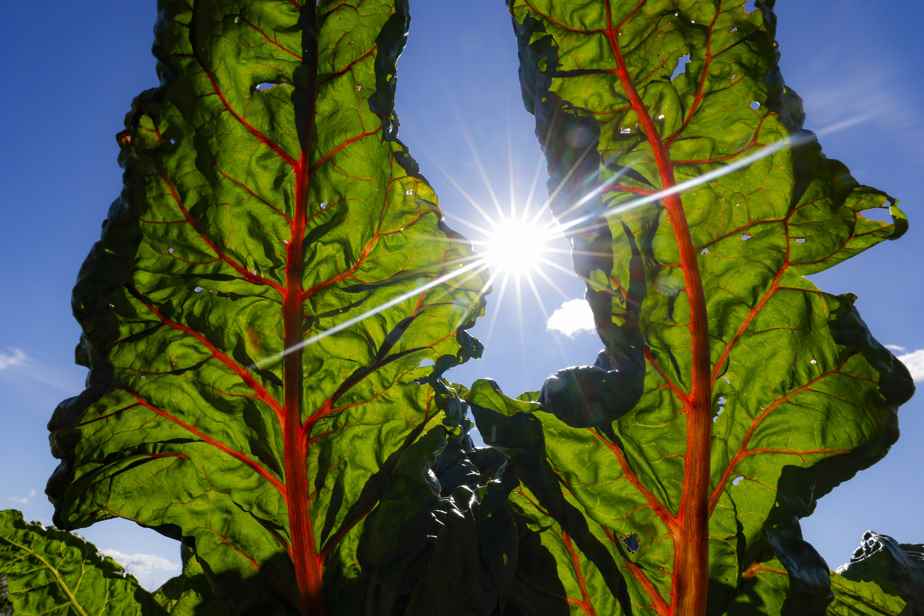Posted at 12:00 p.m.
Foliage
Herbs

PHOTO GETTY IMAGES
Blooming mint
Many species and varieties have variegated or yellowish colors. This is particularly the case with mint. In addition, the very popular basil has several shades of purple. For its part, the “Tuscany” cultivar has dark green, nicely embossed leaves. Without forgetting the borage which gives innumerable small edible blue flowers.
The artichoke

PHOTO PIERRE MCCANN, LA PRESSE ARCHIVES
Artichoke in bloom
A splendor that this giant thistle which requires space. Pale to silvery green foliage, edible flower bud. Often not very productive, it is mainly grown for the beauty of its large blue flowers.
Lettuces

PHOTO OLIVIER JEAN, LA PRESSE ARCHIVES
lettuces
Preferably use leafy varieties, which are easier to grow than head or romaine. Several have very cut leaves with purple or soft green colors.
Cabbage

PHOTO ARCHIVES PRESS
“Glamorous Red” Kale
Some kale cultivars produce waffle leaves, including the popular and beautiful ‘Black Magic’. The “Red Bord” is a fairly pronounced red. Among traditional cabbage, Savoy cabbage is sought after for its waffle texture. This is particularly the case for “Melissa YR”, “Alcosa” and “Formosa”. In addition, you can also plant a few decorative cabbages sold mainly for their show at the end of the season until winter. Some can also be cooked.
The stems
The petioles of some plants show amazing colors. They are edible, if not delicious, although we usually prefer their foliage.
Swiss chard

PHOTO GETTY IMAGES
Swiss chard
From the beet family, Swiss chard leaves taste like spinach. They are the size of a hand and grow on very colorful, shiny petioles. From bright yellow to pink, red, orange and green. The award-winning ‘Bright Lights’ cultivar alone offers a mosaic of colors. The petioles are better and more tender if the leaf is picked earlier than later.
The beets

PHOTO ARCHIVES PRESS
Toad beets
Those with purple roots produce leaves with stems of the same shade, more or less dark, petioles that will embellish the vegetable patch until harvest. Beet greens are excellent. The “Chiggoa” variety with white flesh mottled with red has tender green stems spotted with pink.
The corn

PHOTO HUGO-SÉBASTIEN AUBERT, LA PRESSE ARCHIVES
But
Why not plant some corn plants? Always amazing! Attention, it is necessary to choose a site which will not make shade with the other tenants of the kitchen garden.
fruit and flowers
Runner bean

PHOTO GETTY IMAGES
Runner bean
This climber is famous for its reddish and edible flowers.
Okra

PHOTO GETTY IMAGES
okra flower
An experience to try. From the mallow family, okra (or okra) produces a yellowish flower with an almost black heart. Very similar to hibiscus flowers, like the latter, the okra flower is rather ephemeral before its final transformation. Sometimes sold asHibiscus esculentus.
peppers

PHOTO ARCHIVES PRESS
chili pepper
Several varieties of small peppers are prolific and very decorative. On the other hand, the award-winning varieties “Chilly Chili” and “Pretty N Sweet” are grown for decorative and food purposes. They are sweet. To buy in seedlings to enjoy the beauty of their fruits as long as possible.
yellow zucchini

PHOTO GETTY IMAGES
yellow zucchini
The cultivars are usually early, showy and exquisite. “One Ball” is round, delicious too. To be picked when it is the size of a tennis ball.
Perennials
Some decorative vegetable beds are perennials. It will also be necessary to provide them with a corner where they can grow permanently.
Asparagus

PHOTO GETTY IMAGES
asparagus
We can pick the tips (or turions) in the spring for a more or less long period depending on the maturity of the plant. The 1.5m tall stems are dainty, provide little shade, and turn a beautiful bright yellow or golden in fall.
Chives

PHOTO ANDRÉ PICHETTE, LA PRESSE ARCHIVES
Chive
Delicate stems, edible and very persistent purple flowers.
Egyptian onion

PHOTO ARMAND TROTTIER, LA PRESSE ARCHIVES
Egyptian onion
Produces pretty, strange-looking, edible purple bulbils on large 60 cm hollow stems.
Absinthe

PHOTO GETTY IMAGES
great wormwood
This is the great absinthe, the one sung by poets. We make concoctions. Yellow flowers, very fragrant silver foliage.

